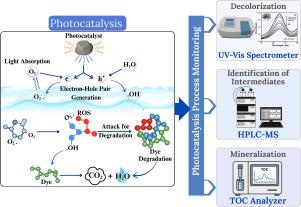Photocatalytic removal of textile dyes: Analytical strategies for post-degradation evaluation
IF 9.8
1区 工程技术
Q1 ENGINEERING, CHEMICAL
引用次数: 0
Abstract
Textile dye pollution poses a serious threat to aquatic ecosystems due to the complex, stable and often toxic nature of synthetic dyes. Photocatalytic degradation, a green and efficient advanced oxidation process, has emerged as a promising solution for removing persistent dye pollutants. This systematic review critically explores the advancements in photocatalytic degradation of textile dyes, highlighting various catalysts, including semiconductors, doped semiconductors and composite nanomaterials. Key operational parameters, such as pH, light intensity, catalyst dosage and dye concentration, are examined for their influence on degradation efficiency. Additionally, this review focuses on post-degradation analytical strategies to evaluate the extent of mineralization and toxicity reduction. Identifying and analyzing degradation products is crucial to ensure complete mineralization and detect any harmful intermediates. However, limited knowledge of suitable analytical techniques often leads to challenges in accurate identification, which can risk misinterpretation or overlook key byproducts. Techniques such as UV–Vis spectroscopy, Raman spectroscopy, TOC analysis, HPLC, FTIR, ICP-MS and GC–MS are discussed in detail for their roles in monitoring dye breakdown, identifying intermediate products and assessing complete mineralization. The interplay between photocatalyst properties, operational parameters and analytical methodologies is highlighted, providing insights into optimizing degradation processes and ensuring reliable assessment of dye removal. By integrating photocatalytic performance with robust post-degradation evaluation, this review aims to guide future research toward more efficient, sustainable and analytically sound strategies for wastewater treatment in the textile industry.

光催化去除纺织染料:降解后评价的分析策略
由于合成染料的复杂、稳定和毒性,纺织染料污染对水生生态系统构成严重威胁。光催化降解作为一种绿色高效的高级氧化工艺,已成为去除持久性染料污染物的一种很有前途的解决方案。本文系统回顾了纺织染料光催化降解的进展,重点介绍了各种催化剂,包括半导体、掺杂半导体和复合纳米材料。考察了pH值、光照强度、催化剂用量和染料浓度等关键操作参数对降解效率的影响。此外,本文综述了降解后分析策略,以评估矿化程度和毒性降低。识别和分析降解产物是确保完全矿化和检测任何有害中间体的关键。然而,对合适的分析技术的有限知识往往导致准确鉴定的挑战,这可能会导致误解或忽略关键的副产品。详细讨论了UV-Vis光谱、拉曼光谱、TOC分析、HPLC、FTIR、ICP-MS和GC-MS等技术在监测染料分解、鉴定中间产物和评估完全矿化中的作用。强调了光催化剂性能、操作参数和分析方法之间的相互作用,为优化降解过程和确保染料去除的可靠评估提供了见解。通过将光催化性能与强大的降解后评价相结合,本文旨在指导未来研究更有效,可持续和分析合理的纺织工业废水处理策略。
本文章由计算机程序翻译,如有差异,请以英文原文为准。
求助全文
约1分钟内获得全文
求助全文
来源期刊

Desalination
工程技术-工程:化工
CiteScore
14.60
自引率
20.20%
发文量
619
审稿时长
41 days
期刊介绍:
Desalination is a scholarly journal that focuses on the field of desalination materials, processes, and associated technologies. It encompasses a wide range of disciplines and aims to publish exceptional papers in this area.
The journal invites submissions that explicitly revolve around water desalting and its applications to various sources such as seawater, groundwater, and wastewater. It particularly encourages research on diverse desalination methods including thermal, membrane, sorption, and hybrid processes.
By providing a platform for innovative studies, Desalination aims to advance the understanding and development of desalination technologies, promoting sustainable solutions for water scarcity challenges.
 求助内容:
求助内容: 应助结果提醒方式:
应助结果提醒方式:


